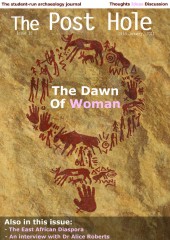Tracey Sweek is a Senior Conservator of stone, wall paintings and mosaics at the British Museum. She studied a conservation programme at the City and Guilds of London Art School between 1983 and 1986. After graduating she worked in private practice with a number of companies until joining the British Museum in 1994. After three years, she left the museum to work with a conservator in Edinburgh to gain experience conserving sandstone objects and monuments. In 1999 she left Edinburgh and joined a London company for a further five years before rejoining the British Museum in 2004. Tracey has a total of twenty-four years experience in conservation but this has been with a various employers. A recent role she has taken at the British Museum is the Project Coordinator for Conservation and Science regarding the World Conservation and Exhibition Centre. This will be a new facility for conservation and science.
SS-What inspired you to become a conservator?
TS-I fell into conservation accidently. A friend of mine from school was attending a fine art course at the City and Guilds of London Art School and happened to mention on an occasion when we met that there was a course on the conservation/restoration of wood, stone and polychrome materials. Immediately I was interested - the course combined all the things I was fascinated by - art, history and archaeology. So I don't feel I was ever inspired because I knew very little about conservation/restoration until I discovered this course but I knew from that point this was what I wanted to do. During the twenty-four years I have been in conservation I have never wanted to do anything else and to be honest, I have been very lucky in the career path that I have followed.
SS-What is your current project?
TS-Currently I have been working in Sudan. Three years ago a request came from the Department of Ancient Egypt and Sudan to visit a site north of Khartoum called Dangeil. The purpose of my visit to this Amun Temple was to determine and implement a conservation programme of protecting the architectural elements. The temple dates from the 1st century AD and comprises of a variety of materials - mud brick, fired brick, plaster and sandstone. Dangeil is a small village close to the Fifth Cataract, and resources are limited both in labour and materials. So for the last three seasons, I have been refining and searching for the materials necessary to complete the conservation as well as training local men in building and capping with lime. The building and lime capping is acting as a sacrificial intervention: the site is exposed to the environment and human activity and this results in the upper elements of the architecture either being displaced or becoming unstable due to the ingress of water. The new building materials are very different to the original and therefore there is no confusion between ancient and modern. The challenges are infinite especially in this remote area of Sudan where resources are limited. There have been problems in acquiring a good source of lime and the heat itself is an ordeal when trying to control the drying of lime mortars. The work will continue for a few more years and it is hoped that the conservation will progress and due to its simplicity will be continued to be maintained by the local workmen.
SS-Do you have any advice for archaeologists looking for a career in conservation?
TS-There are a high number of archaeologists that have moved into the field of conservation especially those wishing to work as archaeological conservators. To follow a career in conservation a student would have to enrol on a degree course in conservation - with no degree it would be hard to find employment. There are a number of courses throughout the country each specialising in various aspects of conservation - archaeology, stone and wood, metals, ceramics to name just a few.




